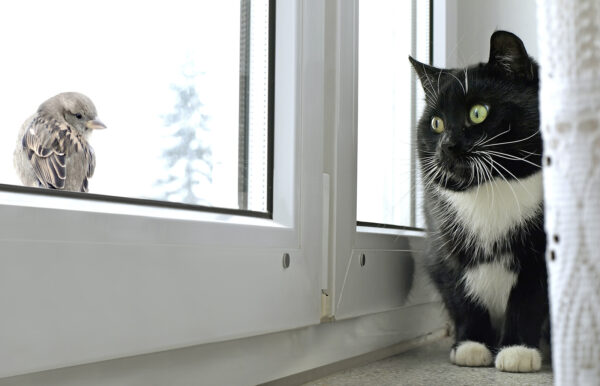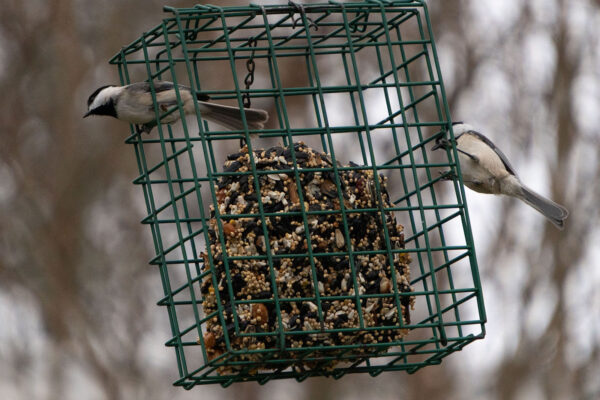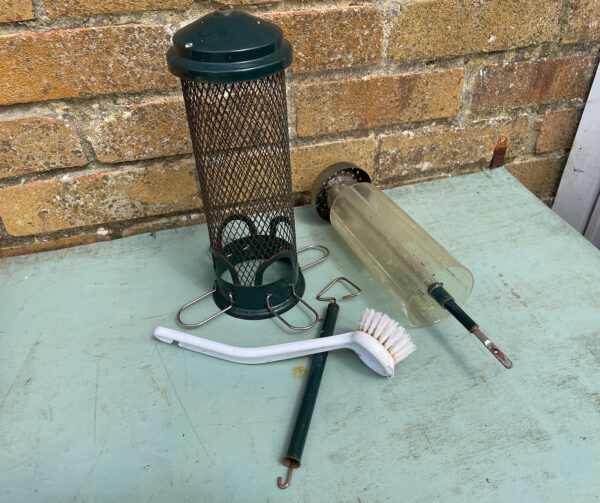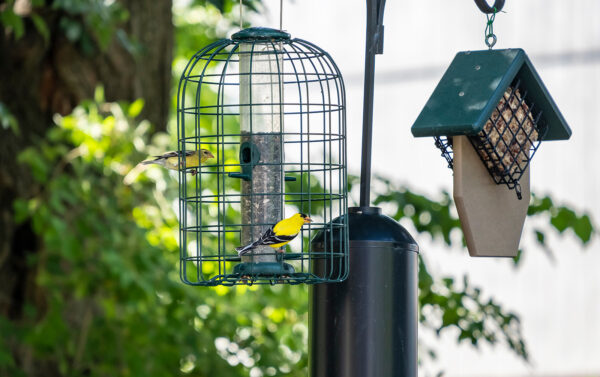Responsible bird feeding is a fun way to observe and learn about birds. There are a few things to watch out for to be sure you’re feeding wild birds in a way that is safe for the birds and for you. The following suggested best practices are provided to help you enjoy feeding wild birds while avoiding issues that can negatively impact birds and other wildlife. In some cases, issues may arise that require you to stop feeding wild birds until the issues are resolved.
Why is Safe Bird Feeding Important?
Disease
Bird feeders concentrate birds into a relatively small area, increasing the risk of diseases spreading from one bird to another. Poorly maintained or dirty feeders also contribute to disease transmission. Some common diseases that can spread at feeders include mycoplasma conjunctivitis (Finch eye disease), salmonellosis, trichomoniasis, aspergillosis and avian pox virus. Disease can be an issue for other wildlife species as well. Bird feeders can attract unnatural concentrations of non-target animals, and the risk of the spread of diseases like mange in bears and Chronic Wasting Disease in deer is increased when these animals congregate at food sources.
If sick or diseased birds are at your feeders or in your yard:
- Remove feeders for at least two weeks and clean thoroughly.
- If necessary, contact a permitted wildlife rehabilitator.
Should I report dead birds?
If you see a sick or dead eagle, owl hawk, or turkey (that is not on or adjacent to a road) OR five or more dead vultures, waterfowl, shorebirds, or seabirds in the same area within five days, please report to DWR by calling the Virginia Wildlife Conflict Helpline at 855-571-9003.

Photo courtesy Shutterstock.
For songbirds or other birds that are suspected to have died from collision with a stationary object or vehicle, or by predation, DO NOT call DWR and safely dispose of the bird by picking up the bird with an inverted bag or disposable glove, placing the bird in another bag, and disposing of it in the trash. Trash receptacles should be secured so that children, pets and wild animals do not have access to them.
Avoiding Predation
Congregating birds at feeders can attract the attention of predators. While these animals higher in the food chain need to eat too, there are a few simple steps you can take to avoid tipping the scales in the predator’s favor.
- Keep cats indoors — even well-fed house cats will hunt and kill birds.
- Some predation at bird feeders is part of the natural process. However, leaving birds exposed when using feeders can increase predation beyond normal levels.
- Be sure to provide cover for birds using your feeders. Native small trees and shrubs (especially evergreens) allow birds to escape predators and avoid harsh weather. Cover should be approximately 10 feet away from feeders.
Uninvited Guests

Photo by Katie Martin/DWR.
It’s not surprising that putting out tasty, nutritious food can attract other animals. Mammals at bird feeders can be especially problematic and range from simple pesky squirrels to issues with rats, raccoons, deer, and bear. Repeated visits from these species of wildlife can create human-wildlife conflict that may be very difficult to resolve. Avoid conflicts by implementing practices that ensure you are feeding only the birds!
- In areas that have high concentrations of bear or deer or other mammalian species like raccoons, remove feeders at night to minimize the attractant.
- Check regulations pertain to wildlife feeding:
- 4VAC15-40-286. Unauthorized feeding of wildlife.
- 4VAC15-20-220. Disease prevention, control and eradication in wildlife.
- 4VAC15-40-281. Unauthorized feeding of bear, deer, or turkey on national forest lands and department-owned lands.
- 4VAC15-40-282. Unauthorized feeding of bear.
- 4VAC15-40-285. Unauthorized feeding of cervids (deer, elk, sika deer etc)
- If a bear is visiting your yard, remove bird feeders (for at least 2 weeks) until they’ve moved on. For more information about living in black bear country visit Bear Wise.
- Feeding bears in Virginia is prohibited. Feeding deer from September 1 through the first Saturday in January is prohibited statewide.
- Feeding deer is prohibited year-round in any CWD management zone (see map below) or counties within 25 miles of a confirmed CWD detection.
- Even inadvertent feeding (like bears raiding a bird feeder) can potentially violate these regulations, especially if attracts wildlife in a way that endangers people or wildlife or creates any public health issues. If issues like these arise, DWR staff may provide notification, after which the continued feeding of wildlife is prohibited
- Ground feeding or loose distribution of seed on stumps, decks or patios is not recommended and can increase potential for disease spread (see tray feeder issues below) and attract other animals.
- Use baffles and place feeders high enough to prevent access by large mammals.
Other Concerns
There are some aspects of wild bird feeding that scientists are still working to understand. It is possible that the feeding of wild birds is leading to changes in the distribution and migration of some species.
Beyond the Bird Feeder: Creating Natural, Sustainable Habitats
The best way to incorporate bird feeders is to make them a part of a backyard habitat, providing a variety of natural resources like native plants in addition to your bird feeders. Creating natural, sustainable habitats supports a wide variety of species and can provide endless enjoyment for you. For more information check out DWR’s Habitat at Home.
How Do I Safely Feed Birds?
- The goal is to be sure that you are indeed “bird feeding.” When other species (especially mammals) are attracted to feeders, issues related to human wildlife conflict and wildlife health often arise. Be willing to stop feeding and adjust how you feed to keep wildlife safe.
- Do not feed waterfowl (geese, ducks, or swans). Feeding waterfowl can lead to concentrations of birds creating wildlife health risks and other issues. Human food, like bread, does not provide proper nutrition to to these birds and can lead to permanent growth deformities.
- Only fill feeders with a quantity of food that will be consumed within your cleaning schedule.
- Keep extra seed in a metal, rodent-proof container stored inside a building or secure structure.
- Discard any seed that becomes wet or damp.
- If crowding at feeders becomes an issue, consider placing multiple feeders spread out as widely as possible.
- Don’t use pesticides or herbicides near bird feeders.
Types of Seed/Food

Photo courtesy Shutterstock.
- Use high quality seed. Preferred seeds include black oil sunflower seed and safflower seed. Safflower is less attractive to squirrels and non-native birds like starlings. Sunflower with the shells removed avoids issues with mess underneath the feeder.
- Nyjer (thistle) seed is especially attractive to goldfinches.
- Unsalted, unsweetened peanuts are attractive to many birds — but to squirrels and other mammals as well!
- Avoid “filler” — Seeds like cracked corn and milo are not eaten by many bird species and can create waste that attracts other animals.
- “Hot pepper seed” (containing capsaicin) can be useful in deterring squirrels and other mammals from eating seed but will not deter bears.
- Suet
- Suet is technically the fat surrounding beef kidneys, but generally refers to any beef fat.
- Commercially prepared suet cakes or blocks can be found at many retailers and may have added seeds, bits of fruit or even mealworms.
- Raw suet can be acquired from some butchers, when rendered (slowly melted) it will last longer and seeds can be added to it
- Do not add household fats or cooking grease to suet.
- Suet can be extremely attractive to mammals like raccoons and bear and must be used responsibly.
- “Hot pepper” suet (containing capsaicin) can be useful in deterring squirrels and other mammals from devouring the suet but will not deter bears.
- Avoid use of suet and similar offerings during warm weather when they can quickly become rancid and/or melt and stick to bird’s feathers. Look for “no melt” suet during the warmer months.
- Hummingbird nectar: A simple 1 to 4 mixture of granulated white sugar to water (ex. 1 cup sugar to 4 cups water) is best. Boil the water and stir in sugar until it dissolves. More sugar is not better. Do not use brown sugar, raw sugar, confectioners’ sugar, or honey. Do not add food coloring. Avoid commercial nectar preparations that contain additives.
Cleaning Feeders

Photo courtesy Shutterstock.
- How to Clean
- Please note: other sources recommend a variety of cleaning methods. These have not been scientifically evaluated and are therefore not included.
- Wear rubber or nitrile gloves
- Take feeder apart and remove any visible debris and gunk that can harbor bacteria. (Bottle brushes can be helpful for reaching down into the bird feeder and thoroughly cleaning out the debris).
- Wash by hand using soap and hot water.
- Soak in a dilute (9 parts water to 1 part bleach solution) for 10 minutes and thoroughly rinse.
- Allow to thoroughly dry before refilling.
- Rake under feeder area to remove any seed hulls or waste.
- How Often to Clean
- Every two weeks (more often during heavy use, damp/wet weather).
- Hummingbird Feeders
- Sugar water solution is an ideal place for bacteria to grow, especially in warm weather.
- Replace sugar water and clean feeder every 2-5 days depending on outdoor temperatures (more frequently the warmer it gets).
- Disassemble and remove any visible film or build-up.
- Soak in a solution of dish soap and hot water.
- Use bottle brush to scrub all parts of feeder.
- Rinse thoroughly and allow to dry completely.
Types of Feeders

Photo courtesy Shutterstock.
- There are wide variety of bird feeders on the market. We recommend those that can be easily disassembled or accessed for proper cleaning.
- Feeders with wooden parts are susceptible to damage from squirrels and can be difficult to clean and sanitize.
- Feeders that can restrict use by undesirable species (such as those with cages or mechanisms that prevent larger animals) still let songbirds easily feed.
- Use baffles that restrict access by other animals.
- For suet
- Use metal cages that can be thoroughly cleaned.
- Consider suet cages designed to restrict access by squirrels and starlings (like upside-down or double cage) but that allow smaller birds such as nuthatches, wrens, downy woodpeckers, and chickadees to feed.
- For Hummingbirds
- Feeders with water filled moat can reduce ant problems.
- Bee guards can reduce attractiveness to bees and other stinging insects.
- Tube feeders with small, attached trays can keep debris from falling to the ground.
Tray Feeder Issues
- DWR does not recommend the use of tray feeders.
- Tray feeders pose special challenges. Birds poop as they feed, contaminating seed in the tray.
- Tray feeders without a cover are exposed to moisture, creating a greater risk of mold and fungal growth.
- Tray feeders are more susceptible to use by other animals.
- If tray feeders are used, ensure that they are:
- Covered
- Well drained
- Cleaned frequently and only stocked with food that will be consumed in a single day
Timing
- During spring and summer months, DWR recommends an emphasis on providing natural habitats that support birds and other wildlife. These natural habitats provide year-round but are especially important during the breeding season
- Natural food sources are most plentiful at this time of year.
- Improving habitat through the planting of native shrubs, trees, and flowers is the best way to sustainably support breeding birds.
- 98% of songbirds feed their young insects, which are in turn supported by native plants… caterpillars are baby bird food!
- There is research that suggests bird nests near bird feeders experience more predation. Feeders generally increase traffic near a nest, creating potential disturbance and increasing the chance that predators may discover a nest.
- In areas of high bear population (see map below) DWR does not recommend placing feeders out during periods of bear activity. Bear activity can vary across the state and from year to year, but generally late fall through late winter are safe periods of time to put out bird feeders.
Birds & Windows
- Window strikes are a major hazard for birds. Birds strike windows either because they see a reflection of the outside world, or because they simply don’t see the glass at all.
- Feeding wild birds and creating backyard habitats may increase the risk of window strikes as birds are attracted closer to our homes.
- There are a variety of ways to reduce the risk to birds from windows. For DIY solutions and products that can help, check out birdsmartglass.org.
- Previous guidance has made recommendations about how close to windows bird feeders should be placed. Current research does not provide a clear answer to this and is therefore not included here.
- “A bird hit my window. What should I do?”
Cease Feeding if Issues Arise or DWR Issues a Recommendation
Under certain circumstances DWR may recommend that people stop feeding wild birds to preserve wildlife and human health. DWR will provide timely updates that clearly identify areas and timeframes for pausing bird feeding.
- Don’t worry — even if you stop feeding birds, they will carry on! Even birds that regularly visit feeders are using a wide variety of natural food sources. Establishing native plants as part of your Habitat at Home will help ensure that they have more than enough to eat.
- You can still enjoy the birds, even without feeders. Birds will still be in and around your yard, especially if you have landscaped with native plants.
- Try downloading apps like Cornell’s Merlin — it can help identify the birds around your yard — even just using the sounds birds are making! Listening to and identifying bird song can be rewarding and fun — you might be amazed at what is using your habitat.
- Explore the Wild and check out natural areas near you.
- The Virginia Bird and Wildlife Trail is a great way to discover new places to see lots of different birds.
Bird Feeding Recommendations

